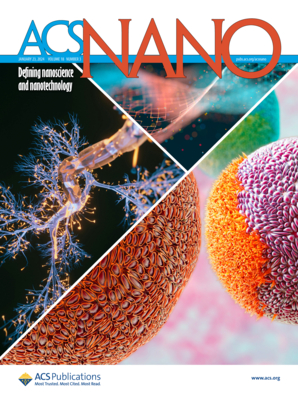Reversible Alkaline Sulfur Cathode Based on Six-Electron Electrochemistry for Advanced Aqueous Sulfur Batteries
IF 15.8
1区 材料科学
Q1 CHEMISTRY, MULTIDISCIPLINARY
引用次数: 0
Abstract
Aqueous sulfur batteries are promising for high-performance and low-cost energy storage. However, their energy density is limited by low battery voltages due to the negative potential [E0 = −0.51 V vs standard hydrogen electrode (SHE)] of low valent sulfur redox (S0/S2–) and low discharge capacity (∼300 mA h g–1) of high valent sulfur redox (S2O32–/S4O62– or S4+/S0). Herein, we develop a reversible alkaline sulfur cathode via introducing Cu2+ and Zn2+ ion mediators, exhibiting a redox potential above 0 V vs SHE, which is higher than low valent sulfur redox and high specific capacity of 1340 mA h g–1. Furthermore, the proposed rechargeable alkaline sulfur batteries achieve a high operating battery voltage of approximately 1.1 V and rapid reaction kinetics, sustained even at high current densities of up to 10 A g–1. In-depth characterization and DFT calculations reveal that the alkaline sulfur electrochemistry follows a six-electron conversion reaction S ↔ CuS ↔ ZnS + Cu2O ↔ Cu, delivering an energy density of 1168 W h kg–1 and a power density of 8110 W kg–1. This work offers insights into aqueous sulfur electrochemistry and shows an alternative to achieving high energy density aqueous batteries.

求助全文
约1分钟内获得全文
求助全文
来源期刊

ACS Nano
工程技术-材料科学:综合
CiteScore
26.00
自引率
4.10%
发文量
1627
审稿时长
1.7 months
期刊介绍:
ACS Nano, published monthly, serves as an international forum for comprehensive articles on nanoscience and nanotechnology research at the intersections of chemistry, biology, materials science, physics, and engineering. The journal fosters communication among scientists in these communities, facilitating collaboration, new research opportunities, and advancements through discoveries. ACS Nano covers synthesis, assembly, characterization, theory, and simulation of nanostructures, nanobiotechnology, nanofabrication, methods and tools for nanoscience and nanotechnology, and self- and directed-assembly. Alongside original research articles, it offers thorough reviews, perspectives on cutting-edge research, and discussions envisioning the future of nanoscience and nanotechnology.
 求助内容:
求助内容: 应助结果提醒方式:
应助结果提醒方式:


